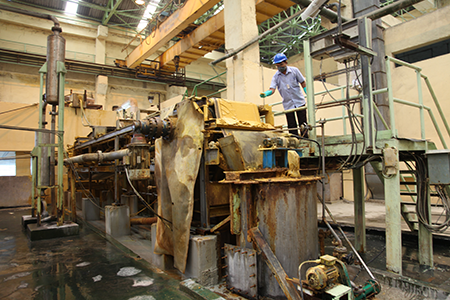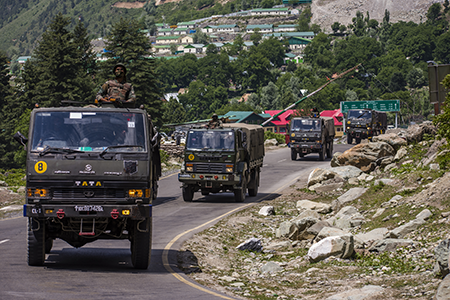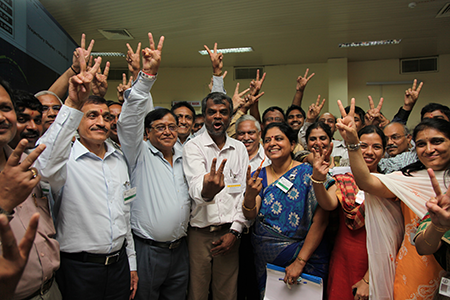"Though we have achieved progress, our work is not over. That is why I support the mission of the Arms Control Association. It is, quite simply, the most effective and important organization working in the field today."
The Legacy of India’s Nuclear Weapons Test
November 2024
By Nasir Hafeez
Fifty years ago, on May 18, 1974, India for the first time detonated a nuclear device at the Pokhran testing site, code-named “Smiling Buddha.” Its leaders claimed they needed this explosive capability for peaceful purposes, such as earth-moving operations, mining, and canal digging.1 Ironically, since then not a single attempt has been made to use a nuclear device to this effect. On the contrary, in 1997, Raja Ramanna, the head of the team that conducted the test, confessed and confirmed in an interview the widespread suspicions that the 1974 Indian nuclear blast was indeed a weapons test.2

Twenty-four years later, also in May and at the same testing site, India conducted five nuclear weapons tests and declared itself a nuclear weapons state. Today, after another 26 years, India is rapidly modernizing its nuclear arsenal and operationalizing its nuclear triad3 under the cover of minimum deterrence and a no-first-use policy. Such a complicated past warrants a retrospective analysis to understand the evolution of the Indian nuclear program and to contextualize the international nuclear cooperation that at its various stages has enabled the development of the necessary infrastructure in this regard. India, despite being critical of the nonproliferation regime, long sought international nuclear cooperation on its own terms and developed the necessary infrastructure for its nuclear weapons program under the guise of peaceful uses. The same process continues even today, albeit in a different manner.
India in the Developing World
India maintains one of the oldest and largest nuclear programs in the developing world.4 Its unique worldview and colonial past play determining roles in adjusting its position on the bargain that led to the nuclear Nonproliferation Treaty (NPT) and other nuclear arrangements.5 Over many years, India has criticized most nonproliferation initiatives, suspecting neocolonial designs. It opposed the U.S. Baruch plan, presented to the UN Atomic Energy Commission in 1946 as the first nuclear disarmament proposal, on the basis that it was meant to prolong the U.S. monopoly over nuclear weapons.6 India has been pursuing strategic autonomy in its foreign policy decision-making, taking a principled stand with its reluctance to be part of any alliance yet benefiting substantially by seeking cooperation from both superpowers during the Cold War under the cover of nonalignment. It is a manifestation of Chanakya Kautilya’s double policy.
India actively participated in all multilateral negotiations on nuclear nonproliferation and disarmament, but refused to enter into any substantial nuclear restraint agreement. In 1965-1968, it was part of the Eighteen Nations Disarmament Committee mandated by a UN resolution to deliberate on the text of the NPT. Although India participated in the negotiations, in the end it refused to sign the final draft and instead proceeded to conduct the nuclear test in 1974. India also played an active role in the negotiations on the Comprehensive Test Ban Treaty (CTBT) at the Conference on Disarmament in the mid-1990s by remaining engaged at all stages of the formulations of the treaty text. Nevertheless, repeating the history, India not only vetoed the treaty by refusing to sign it, but also voted negatively in the UN General Assembly when the CTBT resolution was adopted in 1996. Once again, India followed up by conducting multiple nuclear tests in 1998.
A meticulous, scholarly look at Indian nuclear history reveals consistency and continuity of policy. New Delhi has kept its nuclear options open for the military application of nuclear technology while pursuing a peaceful civilian program and continued seeking international cooperation to develop a long-term technological autarky with respect to nuclear research and infrastructure development.7 Indian scientists and policymakers have been aware of the deterrence value of nuclear weapons since the inception of the Indian nuclear program in 1948. Prime Minister Jawaharlal Nehru and Homi Bhabha, the physicist considered the father of India’s nuclear program, played along with the ruse of the peaceful route as a cover for building the nuclear infrastructure that they could use for weapons-related purposes, if compelled. No pious sentiment could stop them.8

In 1956, India signed a nuclear cooperation agreement with Canada to build its first nuclear reactor. Subsequently, the United States also joined this arrangement and agreed to supply heavy water for the reactor.9 In 1959, India purchased the design of a plutonium uranium extraction plant from Virto Corporation, a U.S. firm whose subsidiary started construction of the plant at Trombay, code named “Phoenix.” This plant was commissioned in February 1964,10 months before the Chinese nuclear test in October.11
In 1963, India signed an agreement with General Electric to acquire two more nuclear reactors for the Tarapur Atomic Power Station as part of the U.S. Atoms for Peace program.12 When the United States signed an agreement with India in 1963 to supply the fuel for India’s first nuclear power reactor at Tarapur, India was allowed to comply with less stringent safeguards than required of other countries.13 Whereas the U.S. Atomic Energy Commission initially insisted on India accepting International Atomic Energy Agency (IAEA) safeguards on the Tarapur plant, India demanded that the safeguards apply only to the U.S.-supplied fuel rather than to the whole plant.14 Thus, the agreement adopted a fuel-based approach to safeguards, rather than the plant-based approach that is usually required by the IAEA.
The U.S. Role in Indian Nuclear Weapons
In this sense, the Indian-U.S. agreement indirectly helped India produce the necessary fissile material for its first nuclear weapon. Restricting IAEA safeguards to the U.S.-sourced fuel allowed India to use non-U.S.-supplied fuel, namely Canadian fuel that was not subject to IAEA safeguards, to make a nuclear explosive device from the spent fuel in Tarapur.15 India refused to accept IAEA jurisdiction over the Canadian fuel.
India already may have acquired sufficient nuclear expertise to conduct nuclear tests by 1964 when China first tested nuclear weapons. Badr-ud-din Tayabji, the Indian representative at the IAEA General Conference in September 1965, gave credence to that assumption when he hinted that India was capable of producing nuclear weapons but had refrained from doing so.16 A month later, almost similar views were expressed by Vishnu C. Tridevi, the Indian representative at the First Committee of the UN General Assembly, when he said that technologically India was undoubtedly “a very advanced nuclear capable country” and that the Indian decision to refrain from manufacturing nuclear weapons was a political calculation.17

Indian scientists understood that they “could use international [that is, U.S.] aid under safeguards to augment an unsafeguarded parallel explosives program.”18 Some experts argued that India violated the letter of its 1961 fuel supply agreement with Canada, which included commitments that the spent fuel, in the form of plutonium extracted from the reactor, would be used only for “peaceful purposes.” Yet, because India did not regard a “peaceful” nuclear explosion as constituting a violation of that agreement, Indian diplomats claimed that the 1974 nuclear test did not violate any agreement with Canada or with the United States.19 Despite these assertions, India “climbed into the nuclear clubhouse on the shoulders of Canadian technology and Canadian aid,” Robert Gillette argued.20
The United States did not publicly criticize the “peaceful” purposes of the Indian nuclear program in view of its strategic concerns against the backdrop of the Chinese nuclear threat.21 Although the United States privately disagreed with the Indian interpretation, officially the Nixon administration stated that “the Indian test did not violate any agreement” with the United States,22 just as India claimed. Eventually, the United States applied no direct sanctions against India. Instead U.S. National Security Advisor Henry Kissinger silenced any talk of sanctions within the administration and allowed the U.S. Atomic Energy Commission to continue fueling the Tarapur plant even after the Indian test.23
The United States responded to the Indian nuclear test on the domestic front by enacting the Nuclear Non-Proliferation Act of 1978, which tightened the requirements for nuclear cooperation. The law imposed tough conditions on nuclear exports, demanding full-scope safeguards and the termination of the agreement if a state conducts nuclear tests or engages in activities related to nuclear weapons manufacturing.24 Less than a year later, a dispute surfaced when the United States decided not to supply low-enriched uranium (LEU) fuel to the Tarapur plant. India criticized the decision because the agreement had guaranteed the uninterrupted U.S. supply of fuel for a period of 30 years.
The United States understood the complication and arranged for the supply of fuel from France to the Tarapur plant until 1993.25 Thereafter, France also introduced a full-scope safeguard policy and ceased supplying the fuel in early 1993.26 Ultimately in 1995, India had to seek supply of LEU from the China Nuclear Energy Industry Corporation.27 Overall on the international front, the Indian nuclear test of 1974 intensified nonproliferation efforts to fill in all the loopholes in the existing international nuclear cooperation agreements being signed between different countries, especially regarding dual-use items. One major consequence was establishment of the Nuclear Suppliers Group (NSG), which was created to exercise strict control on all technologies and materials necessary to build nuclear weapons.
Since the beginning, Indian nuclear policy has aimed to promote the cause of nuclear disarmament in the public sphere while developing the necessary infrastructure for its own nuclear weapons program. While India was discussing the draft of the CTBT at the international level, it was weighing its options to conduct nuclear tests at the domestic level. Two attempts were made to conduct nuclear tests, one during Prime Minister Narsima Rao’s government in December 1995 and later during the short-lived Bharatiya Janata Party (BJP) government in May 1996.28 Both attempts failed due to prior detection of preparations by U.S. satellites and to diplomatic pressure applied to encourage India to abandon the testing plans.
Ever since the establishment of India’s nuclear program, successive governments have pursued the strategy of nuclear ambiguity. The situation changed when the BJP won the 1998 election. Within days of the establishment of the new government, India conducted five nuclear weapons tests on May 11 and 13, 1998, and declared India a nuclear weapons state.29 This display of nuclear weapons capability was not achieved in days or months, but was part of a strategic continuum30 of earlier nuclear policies adopted by previous governments since the inception of the Indian nuclear program.
The international community, especially the United States, criticized the Indian tests, calling them a serious blow to the nonproliferation regime and a threat to international peace and security.31 The United States imposed sanctions immediately after the tests. At the same time, Washington initiated negotiations with New Delhi to explore opportunities for a better relationship between the two countries. The multiple rounds of talks between Indian Foreign Minister Jaswant Singh and U.S. Undersecretary of State Strobe Talbott were an effort to rope India into the prevailing international nuclear order.32 Soon after the 1998 tests, there were already suggestions that India should be enticed with civilian technology to adhere to nonproliferation norms.33 The United States always evaluated developments in the Indian nuclear program with China in the focus and looked the other way as India developed nuclear weapons. Despite the U.S. desire to contain China, India always adopted a cautious approach. It sought strategic partnership and entered into multiple agreements with the United States to develop its national power, but refused to play the part against China as desired.
India managed to break into the international nuclear nonproliferation regime and normalized its nuclear weapons capability in a unique manner. It convinced the United States to acknowledge India’s status as a “responsible state with advanced nuclear technology;”34 to offer a nuclear deal that facilitated an NSG waiver, without India being an NPT signatory; and to allow international nuclear trade with India outside the NPT framework.
It is noteworthy that the existing nuclear nonproliferation regime successfully put in place stringent measures to stop further proliferation of nuclear weapons. The policy of selective application of rules and political expediency creates unnecessary exceptions, however, that dilute the overall impact of vital components of the international security system.
Whether the Indian nuclear program is aimed at China or Pakistan or both countries is not easy to distinguish; it is rather a complex debate about a trilemma that will remain unsettled. How India can manage its deterrence equation with China and Pakistan simultaneously will remain a puzzle. India has shown an inability to confront China openly while dismissing Pakistan as not worthy of attention. This has been evident from Indian Prime Minister Atal Bihari Vajpayee’s letter to U.S. President Bill Clinton at the time of the 1998 nuclear tests and in the ongoing Indian-U.S. partnership where India refuses to be an ally and insists on being only a partner without explicitly mentioning China.
Strategically, India has not been able to achieve what it desired. Although India introduced nuclear weapons into the region, it possibly had not imagined a situation where it could think of a regional nuclear rival. With the NSG in place after the 1974 Indian tests, it was believed that there was little possibility of any further country crossing the nuclear threshold.
To India’s surprise, Pakistan not only initiated a nuclear program, but quickly caught up with India in the acquisition of nuclear weapons.
Had India not tested nuclear weapons in 1974, Pakistan would not have developed its nuclear weapons program with the same zeal and enthusiasm as it did. Had India not tested in 1998, Pakistan would never have tested its nuclear weapons even if it had successfully developed its nuclear weapons capability. India, in pursuit of international prestige or motivated by domestic politics, has created a permanent situation of disadvantage for itself where its conventional superiority is meaningless against a nuclear-armed Pakistan.
ENDNOTES
1. Stockholm International Peace Research Institute, World Armaments and Disarmament: SIPRI Yearbook 1975 (London: The MIT Press, 1975), p. 16.
2. Srinivas Laxman, “Bomb or Peaceful Explosion? 50 Years On, Smiling Buddha Remains a Mystery,” Times of India, May 18, 2024.
3. Hans M. Kristensen et al., “Indian Nuclear Weapons, 2024,” Bulletin of the Atomic Scientists, Vol. 80, No. 5 (2024): 326-342.
4. David Hart, Nuclear Power in India: A Comparative Study (London: Allen and Unwin, 1982).
5. Gabrielle Hecht, “Negotiating Global Nuclearities: Apartheid, Decolonization, and the Cold War in the Making of the IAEA,” Global Power Knowledge: Science, Technology, and International Affairs, Vol. 21, No. 1 (2006): 47.
6. George Perkovich, India’s Nuclear Bomb: The Impact on Global Proliferation (New Delhi: Oxford, 1999), p. 30.
7. Onkar Marwah, “India’s Nuclear and Space Programs: Intent and Policy,” International Security, Vol. 2, No. 2 (Fall 1977): 98.
8. Zia Mian, “Homi Bhabha Killed a Crow,” in The Nuclear Debate: Ironies and Immoralities, ed. Zia Mian and Ashis Nandy (Columbo: Regional Centre for Strategic Studies, 1998), p. 12.
9. International Panel on Fissile Materials, “Global Fissile Material Report 2010,” 2010, pp. 117-118, https://fissilematerials.org/library/gfmr10.pdf.
10. Bhabha’s speech at the inauguration mentioned that plant was completed in February 1964 and the first active fuel element was loaded in June 1964, when the plant began fully operating. This is also corroborated with evidence from U.S. intelligence accounts from the time. See P.K. Iyengar, “Briefings on Nuclear Technology in India,” 2009, p. 38, https://newenergytimes.com/v2/library/2009/2009Iyengar-Briefings%20on%20Nuclear%20Technology.pdf; Tata Institute of Fundamental Research (TIFR), Homi Jehangir Bhabha on Indian Science and the Atomic Energy Programme: A Selection (Mumbai: TIFR, 2009), p. 175.
11. Stuart W. Leslie and Indira Chowdhury, “Homi Bhabha, Master Builder of Nuclear India,” Physics Today, Vol. 71, No. 9 (September 2018): 53-54. See also “Edward Durell Stone Dead at 76; Designed Major Works Worldwide,” The New York Times, August 7, 1978.
12. Satu Limaye, U.S.-Indian Relations: The Pursuit of Accommodation (Boulder, CO: Westview Press, 1993), pp. 93-136.
16. Jagdish P. Jain, Nuclear India, Vol. II (New Delhi: Radiant Publishers, 1974), p. 169.
20. Robert Gillette, “India: Into the Nuclear Club on Canada’s Shoulders,” Science, Vol. 184, No. 4141 (1974): 1053.
24. Sharon Squassoni, “Looking Back: The 1978 Nuclear Nonproliferation Act,” Arms Control Today, Vol. 38, No. 12 (2008).
25. Pearl Marshall, “India and France Renew Old Friendship,” Nucleonics Week, July 4, 1985.
26. Ann Maclachlan Hibbs Mark, “India Can’t Count on France for Tarapur Fuel Past 1993,” Nucleonics Week, April 16, 1992.
27. “Hyderabad Reactor Begins Using Uranium From China,” Business Line, February 20, 1995, p. 9.
28. Perkovich, India’s Nuclear Bomb, pp. 367-374.
29. John F. Burns, “India Sets 3 Nuclear Blasts, Defying a Worldwide Ban; Tests Bring a Sharp Outcry,” The New York Times, May 12, 1998.
30. Zafar Iqbal Cheema, Indian Nuclear Deterrence (Karachi: Oxford University Press, 2010), p. 1.
31. “The Birmingham Summit: Final Communique,” D/98/8, May 17, 1998, https://ec.europa.eu/commission/presscorner/api/files/document/print/en/doc_98_8/DOC_98_8_EN.pdf.
32. Himadeep Muppidi, “Colonial and Postcolonial Global Governance,” in Power in Global Governance, ed. M. Barnett and R. Duvall (Cambridge: Cambridge University Press, 2004), p. 289.
33. Christopher Warren, David A. Hamburg, and William J. Perry, Preventive Diplomacy and Preventive Defense in South Asia: The U.S. Role (Stanford, CA: Stanford University and Harvard University, 1999).
34. Office of the Press Secretary, The White House, “Joint Statement Between President George W. Bush and Prime Minister Manmohan Singh,” July 18, 2005, https://georgewbush-whitehouse.archives.gov/news/releases/2005/07/20050718-6.html.
Nasir Hafeez is director of research at the Strategic Vision Institute in Islamabad.
